Tissue-Specific Cell Signaling » książka
topmenu
Tissue-Specific Cell Signaling
ISBN-13: 9783030444358 / Angielski / Twarda / 2020 / 436 str.
Kategorie BISAC:
Wydawca:
Springer
Język:
Angielski
ISBN-13:
9783030444358
Rok wydania:
2020
Wydanie:
2020
Ilość stron:
436
Waga:
0.81 kg
Wymiary:
23.39 x 15.6 x 2.54
Oprawa:
Twarda
Wolumenów:
01
Dodatkowe informacje:
Wydanie ilustrowane











